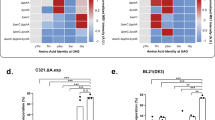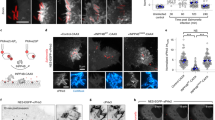Abstract
Phosphorylation–dephosphorylation reactions as a form of regulatory control are assuming increasing importance in our understanding of cellular processes. The phosphorylation–dephosphorylation reaction was the first example of covalent modification in control and has been found to be present in almost every type of cellular process including synthesis of cell constituents, metabolic pathways and even gene expression1. It has assumed increasing importance as a result of the finding that some proteins coded for by carcinogenic viruses apparently are involved in a phosphorylation reaction2,3. To better understand the principles underlying these processes, we have studied the role of phosphorylation of isocitrate dehydrogenase (IDH) in the regulation of the branch point between the tricarboxylic acid (TCA) cycle and the glyoxylate bypass. We report here that in the process of purifying the kinase and phosphatase, we made two surprising observations—the kinase and phosphatase activities appear to be associated with the same protein, and the phosphatase activity has an absolute requirement for ATP.
This is a preview of subscription content, access via your institution
Access options
Subscribe to this journal
Receive 51 print issues and online access
$199.00 per year
only $3.90 per issue
Buy this article
- Purchase on Springer Link
- Instant access to full article PDF
Prices may be subject to local taxes which are calculated during checkout
Similar content being viewed by others
References
Krebs, E. G. & Beavo, J. A. A. Rev. Biochem. 48, 923–959 (1979).
Collett, M. S. & Erikson, R. L. Proc. natn. Acad. Sci. U.S.A. 75, 2021–2024 (1978).
Levinson, A. D., Oppermann, H., Levintow, L., Varmus, H. E. & Bishop, J. B. Cell 15, 561–572 (1978).
Kornberg, H. L. & Madsen, N. B. Biochim. biophys. Acta 24, 651–653 (1957).
Bennett, P. M. & Holms, W. H. J. gen. Microbiol. 87, 37–51 (1975).
Garnak, M. & Reeves, H. C. Science 203, 1111–1112 (1979).
Wang, J. Y. J. & Koshland, D. E. Jr J. biol. Chem. 256, 4640–4648 (1981).
Caban, C. E. & Ginsburg, A. Biochemistry 15, 1569–1580 (1976).
Rhee, S. G., Park, R., Chock, P. B. & Stadtman, E. R. Proc. natn. Acad. Sci. U.S.A. 75, 3138–3142 (1978).
El-Maghrabi, M. R., Claus, T. H., Pilkis, J., Fox, E. & Pilkis, S. J. J. biol. Chem. 257, 7603–7607 (1982).
El-Maghrabi, M. R., Fox, E., Pilkis, J. & Pilkis, S. J. Biochem. biophys. Res. Commun. 106, 794–802 (1982).
Author information
Authors and Affiliations
Rights and permissions
About this article
Cite this article
LaPorte, D., Koshland, D. A protein with kinase and phosphatase activities involved in regulation of tricarboxylic acid cycle. Nature 300, 458–460 (1982). https://doi.org/10.1038/300458a0
Received:
Accepted:
Issue Date:
DOI: https://doi.org/10.1038/300458a0
This article is cited by
-
Characterization of metal binding of bifunctional kinase/phosphatase AceK and implication in activity modulation
Scientific Reports (2019)
-
Differences in possible TCA cycle replenishing pathways in purple non-sulfur bacteria possessing glyoxylate pathway
Photosynthesis Research (2019)
-
Studies on the activation of isocitrate dehydrogenase kinase/phosphatase (AceK) by Mn2+ and Mg2+
BioMetals (2018)
-
Analysis of l-glutamic acid fermentation by using a dynamic metabolic simulation model of Escherichia coli
BMC Systems Biology (2013)
-
Acetate scavenging activity in Escherichia coli: interplay of acetyl–CoA synthetase and the PEP–glyoxylate cycle in chemostat cultures
Applied Microbiology and Biotechnology (2012)
Comments
By submitting a comment you agree to abide by our Terms and Community Guidelines. If you find something abusive or that does not comply with our terms or guidelines please flag it as inappropriate.



